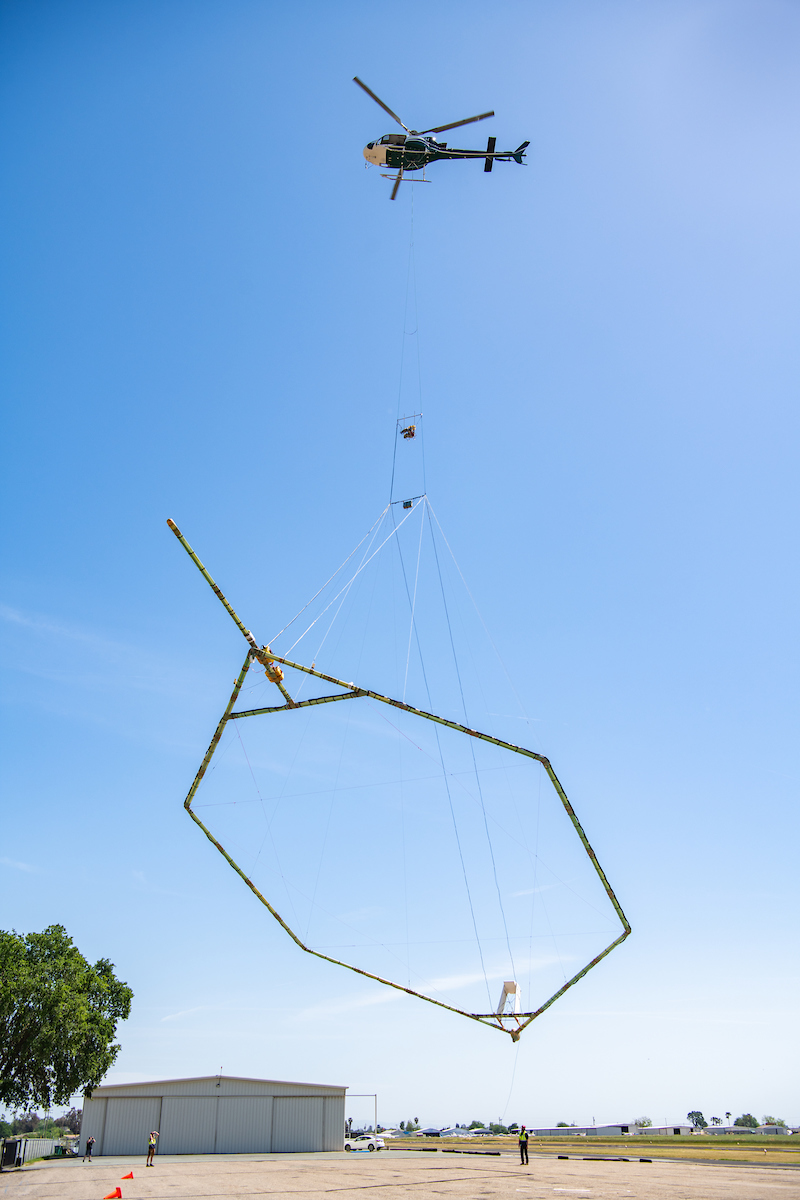The California Department of Water Resources Statewide Airborne Electromagnetic (AEM) Surveys holds an event to learn about AEM surveys, the innovative technology used to conduct them, and how the information gathered supports the implementation of the Sustainable Groundwater Management Act (SGMA). Photo taken April 8, 2022.
State-of-the-art helicopter-based technology and local coordination improve management of our underground water supply
Sacramento, Calif. – National Groundwater Awareness Week is next week, and in the spirit of promoting groundwater knowledge, the Department of Water Resources (DWR) is excited to announce that its innovative groundwater mapping project is complete and will provide critical information about our underground water supply.
The Statewide Airborne Electromagnetic (AEM) Survey Project has now completed surveys in all high-and-medium-priority groundwater basins in California.
AEM surveys use state-of-the-art helicopter-based technology to scan the earth’s subsurface to depths of up to 1,000 feet, like taking an MRI of the earth, to visualize the aquifer structures beneath our feet. You can see the AEM equipment in action in this DWR video: DWR's Airborne Electromagnetic (AEM) Surveys: The AEM Method (youtube.com).
DWR collected nearly 16,000 miles of AEM data within 95 groundwater basins across California between December 2021 and November 2023. This data, which is now publicly accessible, is invaluable for identifying the most suitable locations to implement groundwater recharge projects that can capture water from winter rain and runoff events to store underground for use during dry periods.
The replenishment of depleted groundwater basins is a key action that local agencies are implementing under the Sustainable Groundwater Management Act (SGMA) and is an essential part of California’s long-term water resilience and drought mitigation efforts, as seen in Governor Gavin Newsom’s strategy document, “California’s Water Supply Strategy, Adapting to a Hotter, Drier Future.”
“AEM data helps GSAs move more expediently towards development of projects in areas previously deemed as non-suitable for groundwater recharge,” said Kassy Chauhan, Executive Officer, North Kings Groundwater Sustainability Agency. “AEM has helped to navigate below ground to find the small pockets where the soil conditions are prime for groundwater recharge to occur. The picture of the sub-surface geology helps with project siting and ensures available financial resources are going towards feasible projects which will help get water into the underground helping the North Kings GSA reach its sustainability goals.”
California’s high- and medium-priority groundwater basins provide a major source of water supply for more than 15 million people, especially during dry years when surface water supplies are lacking. As California adapts to a hotter, drier future, groundwater supplies are becoming a more vital resource for communities, households, businesses, agriculture, and the environment that all depend on this critical water source.
“The State continues to make investments in the latest technology, like AEM, to ensure we are prepared for the weather extremes that are playing out in the new climate reality,” said Paul Gosselin, Deputy Director of Sustainable Groundwater Management. “Data from these initial statewide AEM surveys are already being used by local groundwater agencies, and we are excited to move into the next phase, expanding data collection efforts and providing new tools for understanding and managing California's groundwater on a local, regional, and statewide level.”
As the 10-year anniversary of California’s landmark SGMA nears, DWR continues to build on the state’s long history of investigating California’s groundwater basins as part of California’s Groundwater (Bulletin 118). DWR is now moving into the next phase of this work, called Basin Characterization, where new and existing information, including AEM data, will be used to help identify and better understand underground aquifer structures and conditions more clearly than ever before.
DWR is assembling a broad team of experts and coordinating with local agencies to form a workgroup to support this effort to ensure that cutting-edge practices are employed, and results advance local groundwater management. The Basin Characterization Workgroup will aide in coordination and collaboration with local, state, and federal agencies, as well as academia and the private sector.
To support data access equity and allow all Californians to view and analyze this data, DWR developed online AEM Data Viewers. These viewers are revolutionary in the space of viewing complex geologic data as they allow data to be viewed online, without having to purchase specialized software. These tools will enable both the public and technical users to interact with the data in a three-dimensional space, providing a more immersive and informative experience.
DWR’s Basin Characterization efforts will be ongoing as tools and technology improve, in order to increase understanding of California’s groundwater basins and aquifer structures.
In May, DWR will release the next Semi-Annual Groundwater Conditions Update, which will contain the most current statewide groundwater data and information, including Annual Report data submitted by local groundwater sustainability agencies. This data will help provide a clearer picture of the amounts of managed and natural groundwater recharge that occurred during water year 2023.
All of this work is helping local groundwater managers better understand and manage their basins to address both drought and flood response and achieve long-term groundwater sustainability.
For more information:
- Basin Characterization Program (ca.gov)
- Statewide Airborne Electromagnetic (AEM) Survey Project
- DWR's Airborne Electromagnetic (AEM) Surveys: The AEM Method - YouTube
- AEM Data Viewer
- California's Groundwater (Bulletin 118)
- Sustainable Groundwater Management Act (SGMA) (ca.gov)
Contact:
Mary Fahey, Public Affairs, Department of Water Resources
916-820-8083 | media@water.ca.gov
